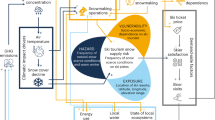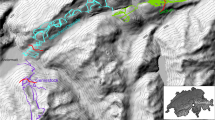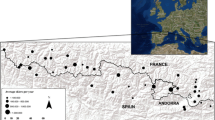Abstract
Winter recreation is an important part of the cultural identity of the Northeast United States and is a multibillion dollar contributor to the regional economy. This study examined the vulnerability of the two largest winter recreation industries, snowmobiling and alpine skiing, to four climate change scenarios for the twenty-first century. Under all scenarios, natural snow became an increasingly scarce resource. The diminished natural snow pack had a very negative impact on the snowmobile industry. As early as 2010–2039, 4 to 6 of the 15 snowmobile study areas were projected to lose more than half of the current season. Reliable snowmobile seasons (>50 days) were virtually eliminated in the region under the A1Fi scenarios by 2070–2099. The large investment in snowmaking substantially reduced the vulnerability of the ski industry and climate change posed a risk to only 4 of the 14 ski areas in 2010–2039, where average ski seasons declined below 100 days and the probability of being open for the entire Christmas–New Year’s holiday declined below 75%. Conversely, by 2070–2099 only four ski study areas had not reached these same economic risk criteria. In order to minimize ski season losses, snowmaking requirements are projected to increase substantially, raising important uncertainties about water availability and cost. Climate change represents a notable threat to the winter recreation sector in the Northeast, and the potential economic ramifications for businesses and communities heavily invested in winter tourism and related real estate is sizeable.


Similar content being viewed by others
References
Abegg B, Agrawala S, Crick F, de Montfalcon A (2007) Climate change impacts and adaptation in winter tourism. In: Climate change in the European Alps: adapting winter tourism and natural hazards management. Organization for Economic Co-operation and Development, Paris, pp 25–60
ACACIA (2000) Tourism and recreation. In: Parry M (ed) Assessment of potential effects and adaptations for climate change in Europe. Jackson Environment Institute, University of East Anglia, Norwich
Associated Press (2006a) Mild weather claims another winter event. http://www.wstem.com. Cited February 2006
Associated Press (2006b) Where snowstorms are desired. Some parts of Northeast suffer because of snowless winter. http://www.cnn.worldnews.com. Cited 17 February 2006
Badke C (1991) Climate change and tourism: the effect of global warming on Killington, Vermont. Thesis, University of Waterloo
Behringer J, Bürki R, Fuhrer J (2000) Participatory integrated assessment of adaptation to climate change in Alpine tourism and mountain agriculture. Integrated Assessment 1:331–338
Bicknell S, McManus P (2006) The canary in the coalmine: Australian ski resorts and their response to climate change. Geographical Research 44:386–400
Bloomfield J, Hamburg S, Heller N et al (1997) Global warming and Northeast’s White Mountains. Environmental Defence Fund, Washington
Bourque A, Scott D (2004) Future outlook – the effects of climate change on the North American ski industry. Paper presented at the Annual Conference of L’Association des stations de ski du Québec and the Ontario Snow Resort Association, Lac Leamy, Québec, 1–3 June
Breiling M, Charamza P (1999) The impact of global warming on winter tourism and skiing: a regionalized model for Austrian snow conditions. Regional Environmental Change 1(1):4–14
Brown R, Braaten R (1999) Spatial and temporal variability of Canadian monthly snow depths, 1946–1995. Atmos–Ocean 36(1):37–54
Canada Country Study (1998) Impacts of climate change on recreation and tourism. In: Responding to global climate change – national sectoral issues. Environment Canada, Toronto
Casola J, Kay J, Snover A et al (2005) Climate impacts on Washington’s hydropower, water supply, forests, fish and agriculture. Centre for Science and the Earth System, University of Washington, Seattle
Cherkauer K, Bowling L, Lettenmaier D (2003) Variable infiltration capacity cold land process model updates. Glob Planet Change 38:151–159
Clean Air–Cool Planet (2002) Fact sheet – global warming threatens Northeast’s ski industry. http://www.cleanair-coolplanet.org/information/pdf/ski-factsheet.pdf. Cited 11 May 2006
Crowe R, McKay G, Baker W (1977) The tourist and outdoor recreation climate of Ontario, volume 3: the winter season. Environment Canada, Toronto
Dritschilo G (2006) Winter washout – unusually mild weather cancels events in the region. http://www.rutlandherald.com. Cited 17 February 2006
Elsasser H, Messerli P (2001) The vulnerability of the snow industry in the Swiss Alps. Mt Res Dev 21(4):335–339
Elsasser H, Bürki R (2002) Climate change as a threat to tourism in the Alps. Clim Res 20:253–257
Erickson J (2005) Changes in the air, part 3: bleak forecast for the ski industry. Rocky Mountain News, 19 March. http://rockymountainnews.com. Accessed 25 August 2005
FAST (2005) Trail grooming – 101. http://fastsnowclub.org/trails101.html. Cited 20 February 2006
Fukushima T, Kureha M, Ozaki N et al (2003) Influences of air temperature change on leisure industries: case study on ski activities. Mitig Adapt Strategies Clim Chang 7:173–189
Galloway R (1988) The potential impact of climate change on Australian ski fields. In: Pearman G (ed) Greenhouse: planning for climatic change. CSIRO, Melbourne
Gates A (1975) The tourism and outdoor recreation climate of the Maritime Provinces. Environment Canada, Ottawa
Goodman J (2005) Battered ski area sweating for snowfall. Seattle Times, 27 October
Hamilton L, Rohall D, Brown B et al (2003) Warming winters and New Hampshire’s lost ski areas: an integrated case study. Int J Sociol Soc Policy 23(10):52–73
Hayhoe K, Cayan D, Field C et al (2004) Emission pathways, climate change, and impacts on California. Proc Natl Acad Sci U S A 101(34):12422–12427
Hayhoe K, Wake CP, Huntington TG et al (2007) Past and future changes in climate and hydrological indicators in the U.S. Northeast. Clim Dyn 28:381–407, DOI 10.1007/s00382-006-0187-8
Hennessy K, Whetton P, Smith I et al (2003) The impact of climate change on snow conditions in mainland Australia. CSIRO Atmospheric Research, Aspendale, Australia
Intergovernmental Panel on Climate Change (IPCC) (2001) Climate change 2001: synthesis report. Summary for policy makers. Third Assessment Report. United Nations Intergovernmental Panel on Climate Change, Geneva
International Snowmobile Manufacturers Association (2006a) International snowmobile industry facts and figures. http://www.snowmobile.org/pr_snowfacts.asp. Cited 18 October 2006
International Snowmobile Manufacturers Association (2006b) Snowmobile facts book – snow trails. http://www.snowmobile.org/snowmobilefacts.asp. Cited 14 February 2006
Johnstone K, Louie P (1983) Water balance for Canadian climate stations. Report DS#8-83. Environment Canada, Toronto
König U (1998) Tourism in a warmer world: implications of climate change due to enhanced greenhouse effect for the ski industry in the Australian Alps. Wirtschaftsgeographie und Raumplanung 28, University of Zurich
König U, Abegg B (1997) Impacts of climate change on tourism in the Swiss Alps. J Sustain Tour 5(1):46–58
Lake County Forest Preserves (2005) Snowmobiling. http://www.lcfpd.org/preserves. Cited 20 February 2006
Lamothe and Périard Consultants (1988) Implications of climate change for downhill skiing in Québec. Climate Change Digest 88-03. Environment Canada, Ottawa
Lipski S, McBoyle G (1991) The impact of global warming on downhill skiing in Michigan. East Lakes Geographer 26:37–51
McBoyle G, Wall G (1987) The impact of CO2 induced warming on downhill skiing in the Laurentians. Cah Geogr Que 31(82):39–50
McBoyle G, Wall G (1992) Great Lakes skiing and climate change. In: Gill A, Hartmann R (eds) Mountain resort development. Centre for Tourism Policy and Research, Simon Fraser University, Burnaby, British Columbia, Canada
Nakienovi N, Alcamo J, Davis G et al (2000) Special report on emissions scenarios: a special report of working group III of the intergovernmental panel on climate change. Cambridge University Press, Cambridge, UK
National Oceanic and Atmospheric Administration (2005) Record warm winter in much of Midwest and Northeast; drought worsens along eastern seaboard, NOAA reports. http://www.noaanews.noaa.gov/stories/s878.htm. Cited 11 May 2006
National Ski Areas Association (2005) Kottke national end of season survey 2004/05, 26th edn. National Ski Areas Association, Lakewood, Colorado
Ontario Federation of Snowmobile Clubs (2006) Trail conditions, January to April 2006. http://www.ofsc.on.ca/trails/trails.asp. Cited 1 January to 7 April 2006
Reiling S (1998) An economic evaluation of snowmobiling in Maine: an update for 1997/98. University of Maine, Orono, Maine
Scott D (2004) Keynote presentation – climate change and skiing in New England. Paper presented at Annual Meeting of the Vermont Ski Areas Association, Ludlow, Vermont, USA, 16–17 June
Scott D (2005) Global environmental change and mountain tourism. In: Gossling S, Hall CM (eds) Tourism and global environmental change. Routledge, London
Scott D, Jones B (2005) Climate change and Banff: implications for tourism and recreation – executive summary. Banff, Alberta, Canada
Scott D, Jones B (2006) Climate change and seasonality in Canadian outdoor recreation and tourism – executive summary. University of Waterloo, Department of Geography, Waterloo, Ontario, Canada
Scott D, McBoyle G (2006) Climate change adaptations in the ski industry. Mitig Adapt Strategies Clim Chang DOI 10.1007/s11027-006-9071-4
Scott D, Jones B, Lemieux C et al (2002) The vulnerability of winter recreation to climate change in Ontario’s Lakelands tourism region. Department of Geography Publication Series Occasional Paper 18. University of Waterloo, Waterloo, Ontario, Canada
Scott D, McBoyle G, Mills B (2003) Climate change and the skiing industry in Southern Ontario (Canada): exploring the importance of snowmaking as a technical adaptation. Clim Res 23:171–181
Scott D, McBoyle G, Mills B et al (2006) Climate change and the sustainability of ski-based tourism in eastern North America; a reassessment. J Sustain Tour 14(4):376–398
Scott D, McBoyle G, Minogue A (2007) The implications of climate change for the Québec ski industry. Glob Environ Change 17:181–190
Snowmobile Association of Massachusetts (2005) Snowmobile association of Massachusetts. http://www.sledmass.com. Cited 17 February 2005
Southwick Associates (2006) The economic contribution of active outdoor recreation. Outdoor Industry Foundation, Boulder, Colorado
Suthey Holler Associates (2003) Community-based ATV tourism product model pilot project. Suthey Holler Associates, Toronto
United States National Assessment Team (2000) Climate change impacts on the United States: the potential consequences of climate variability and change. Cambridge University Press, New York
US Army Corps of Engineers (1956) Snow hydrology. US Army Corps of Engineers, Eugene, Oregon
Wisconsin Department of Natural Resources (2003) Outdoor report for January 16, 2003. http://www.dnr.state.wi.us. Cited 20 February 2006
Wolfsegger C, Gossling S, Scott D (2008) Climate change risk appraisal in the Austrian ski industry. Tourism Review International (in press)
World Tourism Organization (2003) Climate change and tourism. Proceedings of the First International Conference on Climate Change and Tourism. Djerba, 9–11 April
Acknowledgements
The authors are grateful to Katharine Hayhoe and the Union of Concerned Scientists for the assistance with the development of specific climate change scenario information for this analysis, Joel Zigler for his assistance with data compilation and analysis, the helpful comments of anonymous reviewers, and to all of the stakeholders from the ski industry in eastern Canada and the US that have shared their time and insights on a wide range of issues related to their industry. The support of the Canada Research Chair Program by the Government of Canada was also essential to this research.
Author information
Authors and Affiliations
Corresponding author
Rights and permissions
About this article
Cite this article
Scott, D., Dawson, J. & Jones, B. Climate change vulnerability of the US Northeast winter recreation– tourism sector. Mitig Adapt Strateg Glob Change 13, 577–596 (2008). https://doi.org/10.1007/s11027-007-9136-z
Received:
Revised:
Accepted:
Published:
Issue Date:
DOI: https://doi.org/10.1007/s11027-007-9136-z




